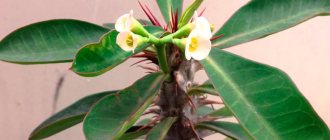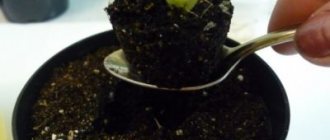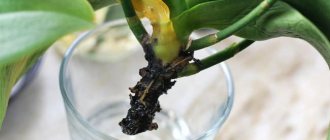What kind of plant is this?
Phalaenopsis rosea is a genus of epiphytic plants belonging to the Orchid family. The herbaceous plant lives in northeastern Australia, the Philippines and Southeast Asia.
A special feature of this species are the round flowers of a soft pink color.
The orchid grows on trees, but does not parasitize due to their nutrients . Loves well-ventilated soil, can grow on stones, rock crevices, usually near water bodies.
Botanical characteristics
Phalaenopsis look like herbaceous bushes with fleshy leaves at the base.
The green bush develops into a powerful root system covered with a layer of wax. Due to the high chlorophyll content, when saturated with moisture, it turns green. Pink orchids, as a species, are small in size. It has leathery, dense leaves arranged in rosettes. They have an oval-oblong shape and a dark green color, although sometimes they are found with a reddish tint. The length of the sheet can reach 15 cm, and the width – 8 cm. As a rule, in the spring and autumn seasons, 1-4 flower stalks appear from the leaf axils.
The peduncle is curved and has a dark purple color. Its length ranges from 25 to 30 cm. Up to 15 light pink flowers , united in rosettes, can grow on one peduncle. They germinate one by one and reach 3 cm in diameter.
Color
Phalaenopsis is naturally white or white-pink in color, sometimes with a slight hint of salmon color. Thanks to breeders who have since ancient times crossed different types of orchids, orchids of other shades have appeared - yellow, blue and others.
Previously , plants with tall peduncles and large white flowers were considered the most valuable . Thus, the image of Phalaenopsis arose, equated to the standard. It is a plant with medium-sized flowers of porcelain white, soft pink or light purple.
Later, breeders developed varieties with flowers whose diameter could reach 15 cm. The natural grace of the orchid was completely lost in hybrid plants of this variety.
Intergeneric hybrids
Representatives of the Orchidaceae family have always attracted the attention of originators. Selection has gone far ahead, and scientists have learned to cross different types of orchids
This is how many unusual hybrids appeared, incorporating the characteristics of the parent pair.
Blue
The natural color of phalaenopsis is snow-white. For a long time, the originators could not develop blue shades until they crossed three species: Violation, Equestris and Doritis Pulcherima. However, bright colors were not achieved. The petals of such hybrid forms are still white, but with a lavender, pale forget-me-not or blue-gray tint. The most famous hybrids: Siam Treasure Blue, Kenneth Schubert Blue Angel, Peter Blue Sky.
The petals of blue phalaenopsis are white with a lavender, pale forget-me-not or blue-gray tint.
Miniature
Cultivars that rarely exceed 0.2-0.3 m in height and have small inflorescences. A striking representative of the subgroup is the Sogo Vivien variety. It is characterized by variegated leaf blades, as well as hemispherical corollas of a soft purple color with a dark veined pattern.
Another popular hybrid is Mini Mark. It is distinguished by the star-shaped flower shape and the snow-white color of the petals, strewn with small red-orange speckles. His lower lip is a single color, bright red.
Mini Mark - representative of the miniature group
Multiflora
Orchids that have several branching arrows, and the buds bloom one after another. As a rule, these are profusely flowering varieties with lush garlands of corollas. The following cultivars are especially loved by gardeners:
- Sogo Yukidan - snow-white orchid;
- Brown Sugar - blooms with brown-purple buds edged with cream;
- Dragon - distinguished by rounded peach inflorescences covered with dark purple small speckles.
Novelty
The only phalaenopsis that continues to form inflorescences on the old peduncle. After the plant fades, new buds begin to form at the top. In addition, the Novelty form can simultaneously release 2-3 arrows. All representatives of this subgroup have a pronounced pattern on the petals. The most popular varieties: Red Pearl, Sapphire Dragon, Montclair.
Pelorics
Orchids obtained by mutation and differing in shape or color uncharacteristic for epiphytes. As a rule, these properties change with each generation, and therefore it is difficult to predict the appearance of a new plant. The breeders were especially good at hybrid forms: Schwartz, Muligan, Big Foot.
Blue
There are no blue phalaenopsis in the wild. The breeders also failed to develop them. If the flower has a bright, rich color (not pale blue), then this is the result of artificial tinting.
The blue color of the petals is the result of adding paint to the growing point of the flower.
Taiwanese
A special feature of this subgroup is the bicolor coloring. Large bright corollas are usually decorated with fancy patterns and have a lower lip that contrasts strongly in color. Also, Taiwanese hybrids are quite unpretentious in cultivation and are easy to adapt. The most famous representatives are: Wild Cat, Big Lip, Golden, Liodoro.
Taiwanese hybrid Wild Cat
As you can see, the choice of indoor orchids is quite varied. The flower wins hearts at first sight. Having grown one type of phalaenopsis, you will certainly want to add more than one variety to your collection.
Types: description and photo
Pink orchids of this variety can be divided into 4 categories, two of which are classified as varieties, and the others as hybrids:
- Schiller.
- Stewart.
- Mini and midi.
- Hybrids.
Schiller
This is the most common variety of orchids of this species, and is native to the Philippines. The plants have a silvery coating on their leaves, which is dotted with dark green spots united into stripes. Most hybrids have been created based on Schiller's orchids .
Phalaenopsis Schiller in hybrid varieties produces a huge number of flowers. A record was recorded - 174 flowers on one peduncle.
Stewart
Almost identical to the Schiller orchid. It differs only in its branching peduncle and small flowers. They have a specific pattern - a transitional tone of pink.
The Stewart's orchid is native to the Philippines, particularly the island of Mandanao.
Mini and midi
Mini and midi orchids are notable for their compact size . The height of midi orchids can reach 40-55 cm, and the length of the leaf is 20 cm with a peduncle thickness of 0.7 cm. Not all of them are pink in color, but some individuals still have a delicate shade.
Hybrids
Orchid varieties with exotic colors:
- Pink Dragon.
- Pink Panther.
- Single pink.
- Pink cherry.
- Grandiflora pink.
- Pink dreams.
- Royal double pink phalaenopsis.
Phalaenopsis can become a decoration for your home; for these purposes, we suggest choosing varieties for growing such as Liodoro, Big Lip, Multiflora, Wild Cat or Mix.
Novelty Phalaenopsis
They are hybrids with non-dying peduncles. After the flowering process, they go dormant, and then grow again from the apical bud. At the same time, new flower stalks often grow, since an adult plant has several dozen at once. Novelti bloom three to four times a year. In most cases, they have a short peduncle with a small number of open flowers. Many varieties of this species belong to miniature phalaenopsis, the leaf span of which does not exceed 20 cm. Novelty phalaenopsis are collection plants. From the side of industrial floriculture, they have a number of negative features.
History of appearance
It is officially recognized that the first pink Phalaenopsis orchid was found on the Moluccas by the naturalist Rumph , who sent it to a scientist friend in Britain. The flower arrived already dry, but the British botanist put it in water. A week later, the UK's first tropical pink orchid bloomed.
In 1752, a flower of extraordinary beauty was found by the Swedish pastor Osbeck in Eastern Indonesia on the island of Ternate. The man sent it to the famous naturalist physician Carl Linnaeus for study.
The scientist described the plant in the scientific work “Classification of the Flora and Animal World.” In it, Phalaenopsis received the name “Epidendrum admirable,” that is, “living in trees.”
Selection
The first hybrid pink orchid was created in 1875 by John Seden , the appearance of flower stalks was noted in 1886. During this time, 13 more primary hybrids were bred.
In 1920, the first large-flowered Phalaenopsis was created in France. And after 7 years there was a second one, with a large size and a rigidly defined flower shape. In 1940, the large-flowered orchid grex was created. It differed from its analogue in the large number of flowers on the peduncle and flat, dense, pure white flowers.
It was not until the 1950s that high-quality rose flowers were produced . The basis was an orchid with petals that have a pinkish tint on some parts and a large-flowered hybrid. After 10 years, the direction of the breeders changed - a wave of creating miniature Grexes began.
Care
The orchid is a capricious plant that requires strictly defined conditions for its maintenance:
- Temperature regime . The plant requires a minimum of 20oC in winter and up to 35 in summer. Temperatures dropping to 100 at night can kill a pink orchid.
- Location . Pink Phalaenopsis does well on windows facing east or west.
- Light .
In winter, the plant requires additional lighting using fluorescent lamps. The pink orchid requires 12 hours of daylight for normal growth. - Watering . Pink orchids require moderate watering. In summer, they are moistened as they dry - two to three times a week; in winter, the volume is reduced to several times a month. The water should be settled and at room temperature.
Top dressing
The pink orchid must be fertilized with a complex product for orchids. It is added to the moistened substrate so as not to burn the root system. Too much fertilizer can lead to cracks in the leaves and lack of flowering. When choosing a fertilizer for a flower, you need to choose one with the lowest nitrogen content.
Transfer
Moss, pine bark, and charcoal are used as soil for pink Phalaenopsis . Plants are planted in transparent plastic pots to control the position of the roots, monitor the need for moisture, and prevent the plant from dying off.
Transplantation is carried out only when absolutely necessary, once every few years. The procedure is performed only after flowering. The bottom of the pot is covered with drainage. Dried roots are cut off and the old soil is cleaned out. The orchid is placed in a new pot and carefully covered with substrate, without pressing it to the roots.
We invite you to watch a visual video about orchid transplantation:
Reproduction
Daughter plants can be separated during transplantation. Orchids can also be propagated by children that sprout on the flower. Young inflorescences will appear after about a year .
Pests and diseases
- The most common problem with pink Phalaenopsis is root rot. The flower can be saved by timely pruning of the affected areas, replacing the soil and reducing the amount of watering during the recovery period.
- The orchid is susceptible to attacks from aphids and red mites, which spread from a diseased plant to a healthy one.
When purchasing a flower, you need to carefully examine the leaves and flowers; you can notice lesions on them from mealyworms when infected with parasites.
The pink orchid is a rather capricious plant to care for . However, if you follow all the above recommendations, a flower “like a moth” can bloom on your home windowsill, which has delighted the eyes of scientific botanists and ordinary people for hundreds of years.
Main features of flowering
In potted culture, phalaenopsis blooms 2-3 times during the year. About 15 flowers bloom on a dark purple peduncle.
The buds begin to bloom gradually, one after another. Thanks to this, the flowering period of the plant lasts from 2 to 6 months.
To stimulate and prolong flowering, conditions that are comfortable for the plant are created:
- for irrigation we use water at about 35 degrees;
- the night temperature in the room should be 5 degrees less than the day temperature;
- it is prohibited to replant a flowering plant;
- To preserve the unique color, we increase the fertilizing.











